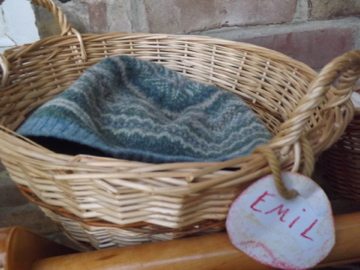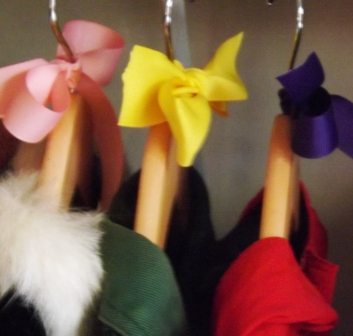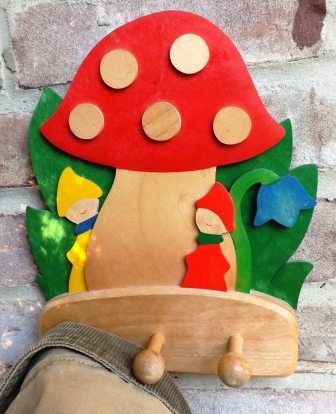We tend to think of rhythm as a schedule or a sequence of activities that flows with the energy of the day, the energy of the week and the energy of the seasons. Yet there is another type of rhythm that surrounds us all the time, the rhythm of the familiar, the predictable, and the reliable. The rhythm and repetition in the spaces we inhabit.
When a new school year or child care year begins, each child and each family wants to know, deep within, where do I fit in, how do I belong? It is one of the most basic questions of human beings and said by some to be the most fundamental of all human needs ~ to belong. How do we, as teachers, childcare providers and parents of more than one child, help each child feel that he or she belongs, yet keep them all enveloped in the warmth of feeling part of the whole?
Well, we might ask, what is unique to each child within the group, what are the physical belongings that are unique to the child and how do we organize them to be distinct from the group, yet part of the group, particularly when writing has not yet been introduced and a child has not yet had the discovery of what his or her name looks like in letters?
We might create a symbol; this is a tradition that has emerged over the years.
There are many stories about the esoteric qualities of symbols and teachers’ meditations in choosing the right symbol for each child. The story I was told about the origin of the use of symbols in the kindergarten came from Susan Howard. It goes like this; a long, long time ago, maybe thirty or forty years ago, a kindergarten teacher had painted a small mural on the wall above the coat hooks where the children hung their coats. The mural depicted a lovely scene from nature, a meadow with a running brook, flowers and trees, gnomes and crystals, rabbits and squirrels. The children’s names were also printed on the shelf above the coat hooks for parents and other teachers to know where each child’s belongings were kept.
The children came to know the place where they were to hang their coats by what they saw painted nearby on the mural. A child might hang her coat in the flowers, or by the brook or next to a squirrel. Another child’s coat might be hung near the tall tree or beneath the drifting clouds. The symbol was associated with the place where the coat was hung rather than the essence of the child.
It is from this mural that the practice of associating children’s belongings with a symbol was born and slowly spread through kindergartens and nursery programs and has become a “tradition.” Little by little, the child has become associated with the symbol rather than the place where the coat was hung. “He’s a rainbow,” “She’s a squirrel.” How is it for a small child to hang his coat next to the squirrel? How does that compare to being the squirrel? Are the children becoming identified by their symbols?
Over the years, the children’s symbols have come to be used at cubbies, on chairs and cups and napkins and capes and placemats, on handwork baskets, sewing boxes, pillows and hand towels.
Yet in trainings, we are all cautioned to be conscious about our habits with the children, to awaken ourselves to our own actions as well as unintended consequences for the children, the classroom, ourselves. We learn through child development to avoid prematurely awakening the children to abstract images.
How does the child take in this experience, to be a rabbit or a flower? What is the experience for the child to become the thing, to be the image, “here is the rabbit’s cup,” “here is the flower’s basket,” day after day, through the year? It’s easy to slide into associating the child with the object rather than the coat with the place on the mural. How is it for the child to be the object rather than to be the self, the subject, to be Susie or Michael or Sam?
Each child has received a name at birth, an individual name, given by the parents. We include that name as an integral part of the birthday story. When that name is sung or spoken with love, it supports the development of the child, and the uniqueness of the individual, of the human being. It creates a feeling of belonging.
This conversation changed my experience of the symbol. I wondered how to note the place for the child’s coat and boots and cap, how to mark the child’s place at the table day after day, through the year, to bring recognition of the child’s place, the gentle reminder of where things go and where to sit without awakening the child or assigning a symbol that may over time come to define the child.
I wondered how to do this in a way that would not associate the child with the thing, with the object. I decided to try ribbon.
 I tied a piece of grosgrain ribbon around the neck of the hanger, a different color for each child to communicate that this hanger is waiting for this child. Each day the child used the same hanger with the same ribbon to hang her coat. Over time the child’s finger knitting might come to wrap around the neck of the hanger.
I tied a piece of grosgrain ribbon around the neck of the hanger, a different color for each child to communicate that this hanger is waiting for this child. Each day the child used the same hanger with the same ribbon to hang her coat. Over time the child’s finger knitting might come to wrap around the neck of the hanger.
Caps go into a basket with the same colored ribbon. Mittens go on the heater. Boots are paired up neatly on the boot mat. Some years I make a little clothes pin gnome or fairy of the same color as the ribbon, to clasp the tops of the boots together.
The child can be reminded with a pat of the hand on the chair bottom, that this is his seat at the table. The daily repetition of this act can help each child find his seat at the table.
Names can be written on a slip of wax paper with a beeswax crayon and placed under a child’s bun dough on baking day. The child’s name can be sketched with care and love on the back of the child’s painting paper and marked in the lower corner of the child’s coloring page. The children noticed the unique aspects of their bun, of the shape they had created. They did not seem so focused or awakened by their name, after all they have been using it since birth.
For the parents, I hung a cotton cloth pocket shoe hanger. At each pocket pouch, I fastened a nametag of the family name with the same color ribbon or yarn as the child’s coat hanger. This served as a place to drop and pick up handouts, messages, calendars and community events. Parents began leaving notes for each other in these pockets. It became a way for them to connect.
What I came to observe with my little group, is that it is the slow and loving gesture of doing the same act, day after day, week after week, through the year, of taking time, of putting the coat on the same hanger, of placing the cap in the basket, of lining the boots or shoes up just so with care before putting on the slippers, that it is the gesture done repeatedly and full of care that brings a feeling of warmth and belonging to the child and the group.
Photographs by Lisa Boisvert Mackenzie
Lisa Boisvert Mackenzie is a mom to boys and an early childhood teacher, as well as the editor of The Wonder of Childhood online magazine. She blogs at Celebrate the Rhythm of Life.
We thank you for stopping by to enjoy this article. If you would like to share your experiences working with children in a LifeWays home or center, please feel free to contact Mara Spiropoulos at linearmara@gmail.com. She would be thrilled to work with you to share your wisdom and experiences on the LifeWays blog.

The use of the printed name
Lisa, Thank you for this thoughtful pondering on the use of symbols. I have often wondered about it. I know it holds some kind of “taboo” to label a child’s hook or drawer with his/her name, because it is introducing the printed word too early. My own view on this is that the child’s printed name is not just an abstract mixture of symbols. The letters in his name form a distinct shape, and over time the child learns to recognize that shape and very proudly announces, “That’s my name!” The name given to him by his parents at birth. So this is a special “symbol” indeed, and I have never understood why we would be reluctant to use the beautiful and relevant symbol of a child’s printed name.